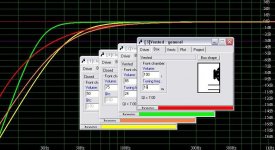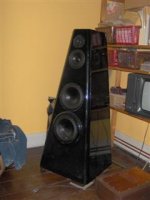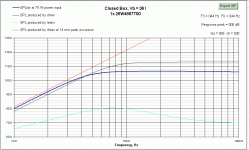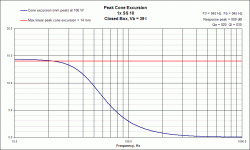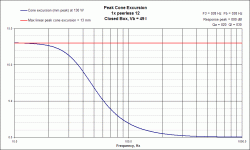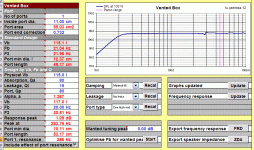Hi,
Attached is some simple modelling of the Scanspeak.
The shown "room friendly" vented alignment is somewhat impractical
IMO requiring a very low vent frequency and a big box for a 10".
A half the size sealed box seems more practical.
Sealed versus vented there is no simple answer IMO.
The two vented alignments shown will sound very different (albeit
my experience with such alignments are at higher vent frequencies).
Wide baffle speakers, AFAICT TG's enthusiasm for these has cooled
somewhat, probably / possibly related to the "critical distance" effect :
see : http://www.pispeakers.com/ssdm_99.pdf pages 5-14
Very room and listening distance dependent. Some listeners prefer
the directness of being inside the CD (especially line arrays / horns),
some prefer the more spacious and laidback presentation of being
outside the CD with the sound image being "over there", I'm the latter.
 /sreten.
/sreten.
Attached is some simple modelling of the Scanspeak.
The shown "room friendly" vented alignment is somewhat impractical
IMO requiring a very low vent frequency and a big box for a 10".
A half the size sealed box seems more practical.
Sealed versus vented there is no simple answer IMO.
The two vented alignments shown will sound very different (albeit
my experience with such alignments are at higher vent frequencies).
Wide baffle speakers, AFAICT TG's enthusiasm for these has cooled
somewhat, probably / possibly related to the "critical distance" effect :
see : http://www.pispeakers.com/ssdm_99.pdf pages 5-14
Very room and listening distance dependent. Some listeners prefer
the directness of being inside the CD (especially line arrays / horns),
some prefer the more spacious and laidback presentation of being
outside the CD with the sound image being "over there", I'm the latter.
Attachments
sreten said:Hi,
Some listeners prefer the directness of being inside the CD (especially line arrays / horns)
some prefer the more spacious and laidback presentation of being outside the CD with the sound image being "over there", I'm the latter.
/sreten.
I suppose you have had that experience with those speakers to back up such claims, but I do think that its a bit too simple way of looking at a complex thing like a loudspeaker
Its my experience that when it all falls in place, you can actually have it all in one, although I admit not to have much experience with many different designs as I have used most of my efforts on one design, a 3way with double 8" woofer(ScSp) in closed, 5" Revelator, Vifa XT25, the mid could have a bit more sensitivity
They are almost perfect, but at the moment a bit boring, so they are sold to a good friend, and I am heading towards something bigger with pro drivers

Attachments
tinitus said:
I suppose you have had that experience with those speakers to back up such claims, but
I do think that its a bit too simple way of looking at a complex thing like a loudspeaker.
Its my experience that when it all falls in place, you can actually have it all in one ....
I want it all, I want it all, I want it all, ..... I want it now ......
Who's being simplistic / naive ? You cannot have everything .....
CD's are far from being simplistic and it reflects arbitrary point(s)
where the direct and reverberant sound are equal, which may/will
vary with frequency. As a concept it is as good as anything else.
Like much of the JBL Sound System Design Reference Manual each
section should not be taken literally on its own, you have read all
of it, my apologies if the manual is too simplistic for you .....
...
Figure 5-20 is a universal relationship in which critical distance is used as the measuring stick.
....
Once DC (CD) is known, all other factors can be calculated without regard to room characteristics.
...
Two quotes not to be taken literally .... only true in the given context ....
Sreten,
What software did you use to model those?
I have the 26W8861T00 Scanspeak Revelator and I use Unibox which gives me the result of 35L fully stuffed in a sealed box. Still I got -3dB at 50Hz or something like that.
Your result is so much different from mine.
Regards,
Bill
What software did you use to model those?
I have the 26W8861T00 Scanspeak Revelator and I use Unibox which gives me the result of 35L fully stuffed in a sealed box. Still I got -3dB at 50Hz or something like that.
Your result is so much different from mine.
Regards,
Bill
HiFiNutNut said:Sreten,
What software did you use to model those?
I have the 26W8861T00 Scanspeak Revelator and I use Unibox
which gives me the result of 35L fully stuffed in a sealed box.
Still I got -3dB at 50Hz or something like that.
Your result is so much different from mine.
Regards,
Bill
Hi,
WinISDbeta
As I said "simple modelling" so Vbox is the effective box volume.
I understand "full stuffing" can increase box volume by up to 40%,
(depending on what you read / tests you peruse, I'm not sure)
so 35L fully stuffed can be <=> 50L.
WinISDbeta is quick and simple but very limited, it simply
saves doing the basic maths, I just plug in Vas, Fs and Qts.
The basic maths for Vas, Fs and Qts indicate that to bring
up Qts from 0.3 to 0.7 you need ~ 50L, and this brings up
Fs 18Hz to Fbox ~ 45Hz, as it is Q = ~ 0.7 Fbox = ~ F-3dB.
I'm not familiar with all of what Unibox takes into account but
no doubt it is far more accurate that WinISDbeta for real boxes.
http://www.rjbaudio.com/Audiofiles/FRDtools.html
States Unibox is the best free box simulator.
I also use WinISDProAlpha which is more advanced than Beta.
Its friendly to use but again I do trust it completely, but the
quick power handling / excursion modelling is useful.
Also useful is the quick (incomplete) modelling of additional
active EQ for vented 6th order alignments, sealed 4th order.
Sreten,
I have tried WinISD a while ago. From my memory it does not calculate the effect of stuffing, therefore I used UniBox. Even if stuffing is not taken into account, I found that there were descrepancies (not too small from my memory) between the two. I prefer the curves produced by WinISD because they look better. However, there is only one truth so one of them has to be more accurate than the other. I don't know which one is more accurate. Interestingly there is only one set of T/S parameters.
Regards,
Bill
I have tried WinISD a while ago. From my memory it does not calculate the effect of stuffing, therefore I used UniBox. Even if stuffing is not taken into account, I found that there were descrepancies (not too small from my memory) between the two. I prefer the curves produced by WinISD because they look better. However, there is only one truth so one of them has to be more accurate than the other. I don't know which one is more accurate. Interestingly there is only one set of T/S parameters.
Regards,
Bill
Hi,
WinISDbeta does the simple calculations automatically.
They are mathematically perfect, but so what .......
That is all you need to understand is that is what is does.
I've no doubt Unibox is the best freeware.
But again you need to understand what it does.
The description page does not describe how stuffing is modelled.
http://home20.inet.tele.dk/kou/ubmodel.html
 /sreten.
/sreten.
WinISDbeta does the simple calculations automatically.
They are mathematically perfect, but so what .......
That is all you need to understand is that is what is does.
I've no doubt Unibox is the best freeware.
But again you need to understand what it does.
The description page does not describe how stuffing is modelled.
http://home20.inet.tele.dk/kou/ubmodel.html
G.Kleinschmidt said:
Revelator woofers from Scan-Speak operating in sealed enclosures, this 10” unit in particular
for the same money as a subwoofer (sub 100Hz) this woofer might offer more esp. when doubled up.
http://www.madisound.com/catalog/product_info.php?cPath=45_338_380&products_id=1347
I am torn between the SPL capability of a 18cm midbass (Audiotechnology, SS, Seas) vs the better radiation of a 15cm midbass (some the same manufactuers).
If you have room behind the speakers this is one option to the Delta
http://www.troelsgravesen.dk/JA8008_DTQWT.htm
or the above SS woofers mated to this
http://www.troelsgravesen.dk/CNO.htm
or any of these
http://www.troelsgravesen.dk/W15.htm
http://www.troelsgravesen.dk/EllamXT.htm
http://zaphaudio.com/ZD5.html
jupiterjune said:
The only way you will really ever know will be by doing listening comparisons with both vented and sealed!
JJ
I agree.
Here is perhaps another contender for the bass driver (assuming a sealed box):
http://www.madisound.com/catalog/product_info.php?cPath=45_338_381&products_id=8265
I think this one was mentioned previously but I may have overlooked it.
It does a lower f3 and it seems to have specs suited to a sealed enclosure - high VAS (although significantly lower than the Scan-Speak unit) and an EPB of 50. It has a higher "linear excursion" (13mm Vs 9mm) also, but how much that may be offset at high SPL in a sealed box due to the lower VAS (or other characteristics) I do not know.
Since it seems that an ultra low f3 may not be of great significance given room gain (if that’s the correct term) it still looks attractive because it is a lot cheaper than the Scan-Speak unit.
Anyway, a quick Q:
Attached below is a unibox cone excursion sim of the Scan-Speak unit. It hits its Xmax of 14mm at ~80W <30Hz.
My amp will drive a 4-ohm driver to 200W.
Would that be considered excessive?
Cheers,
Glen
MJL21193 said:Hi Glen,
Here's how the excursion for the SS driver should look in a sealed box:
Hi John.
I can never get that graph to produce an output that makes sense and have to resort to WinISD.
What values to you put in for:
Physical Vb
Absorption, Qa
Cheers,
Glen
G.Kleinschmidt said:
Anyway, a quick Q:
Attached below is a unibox cone excursion sim of the Scan-Speak unit.
It hits its Xmax of 14mm at ~ 80W <30Hz.
My amp will drive a 4-ohm driver to 200W.
Would that be considered excessive?
Cheers,
Glen
Hi,
Is is the 200W power excessive ?
In a high passed subwoofer application the general argument
is that amplifier power and linear Xmax should be moreorless
equal, if the power is lower you get cleaner bass, but if it is
higher you get more headroom higher up where the driver
is power handling limited rather than excursion limited.
For HT one could argue power = the excursion limit, for
music one could argue for more headroom higher up.
However I presume we are not talking high passed subwoofers.
That is : the amplifier is producing the voltage swings for
the whole frequency range, not just the high passed bass.
In this case excursion limiting at ~ 40% of the amplifiers
maximum power is more than adequate for music.
How much more than adequate it is can be argued about
but the reality is AFAIK 1/10 to 1/4 is more than enough in
(1/10 = classical, acoustic stuff etc, 1/4 = bass heavy)
nearly all cases otherwise normal domestic speakers would
always be overloading in the bass when given some juice.
(Has to be said cheap speakers do overload in the bass)
Or put it another way, a speaker than can handle say 200W music
program (400W peaks with mild clipping) and handle a minimum
of 50W rms at any bass frequency would be regarded as having
outstanding bass power handling.
If this is allied to very good bass extension (which as you go
lower reduces power handling) then you are in the realms of
outstanding bass full stop.
If set at 1/2.5 < 30Hz this is well into the comfort zone,
so no, the 200W amplifier capability is not excessive.
In reality at the amplifiers maximum clipping limited
volume with nearly all music it will never be exercised.
G.Kleinschmidt said:
What values to you put in for:
Physical Vb
Absorption, Qa
The actual box size for a sealed box is a compromise between response (#1), size limits (#2) and power handling (#3). There is wiggle room to improve one of these factors, usually at the expense of the other 2. You can experiment by changing Vb to find the best fit for your needs.
I try to keep the QTC around .7 and aim for the best response, check that I don't have something the size of an ocean-going container and make sure the driver is not running out of excursion for the power I plan to use.
The Qa is determined by the stuffing and it has an effect on the "apparent" box size. Full stuffing is a Qa of 5 and the box will perform as though it is quite a bit bigger. No stuffing will be Qa of 120. I usually use the Damping drop down list to fill this in, unless I have something special in mind. This aspect of the program is good but leaves room for error, as the amount of stuffing and type may not correspond to what has been modeled.
and make sure the driver is not running out of excursion for the power I plan to use
and how do you determine how much power that will be? i use 50% of my rated amp because i doubt i will ever have my amps maxed but this is an uneducated guess.
suggestions please
blue934
blue934 said:
and how do you determine how much power that will be? i use 50% of my rated amp because i doubt i will ever have my amps maxed but this is an uneducated guess.
suggestions please
blue934
Hi blue,
I learned how to use Unibox properly and that has been a real bonus for this kind of modeling.
Before, I worked out box volume and alignment by formula and used different calculators but this was either tedious and time consuming or just plain inaccurate.
A few years ago, I had a 12" Max Pentivent speaker that I used in a sonosub, The calculator that I used at the time lead me to expect that a 350 litre vented box was right.
Short from a long story is that the Pentivent was running out of excursion in that box at less than 25 watts! I found this out by modeling it in Unibox, long after I pulled the Pentivent out and burned the sonosub out in my back yard.
You can't judge how a driver will behave by power rating. It needs to be properly modeled and simulated. Unibox has not let me down - everything I model has worked exactly as predicted.
i persume the excursion graph in winisd or bassbox that i use are similar to what you are saying about unibox. my problem is knowing how much power to apply to the graph. does my 240w plate amp need 240w applied to the graph ,or, since i will never have my amp at max, should i use 50% or 75% or?
i guess i am asking do i model for max power or normal listening levels?
blue934
i guess i am asking do i model for max power or normal listening levels?
blue934
blue934 said:
i guess i am asking do i model for max power or normal listening levels?
I model max power.
A lot of what you are saying was mentioned above in sreten's post. I don't do it that way.
For me, there is no "normal" listening level. I like to crank it more often than most and I don't want my drivers struggling with the load.
You need to decide what you want out of the design - what will be the spl at the power level you think you won't exceed? To get an acceptable level at low frequency requires power, therefore power handling ability.
In my post #33, the projected frequency response has the speaker (driver and port) producing 104db at 20Hz at 130 watts. This is within the drivers linear excursion limit.
Is this enough or is more output needed? If your amp is only able to produce 100 watts, you don't need to worry that your driver is distorting from over excursion.
- Status
- This old topic is closed. If you want to reopen this topic, contact a moderator using the "Report Post" button.
- Home
- Loudspeakers
- Multi-Way
- Scan-Speak Revelator
